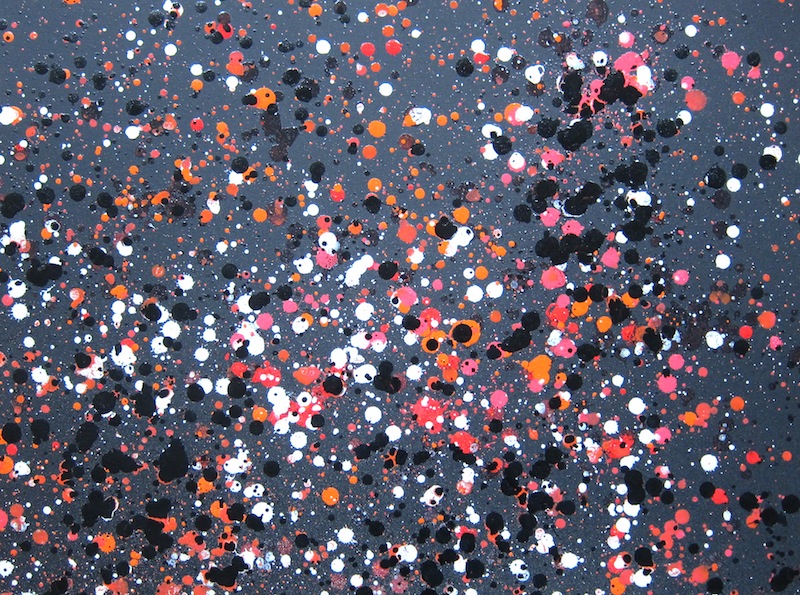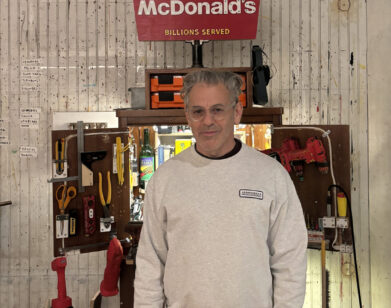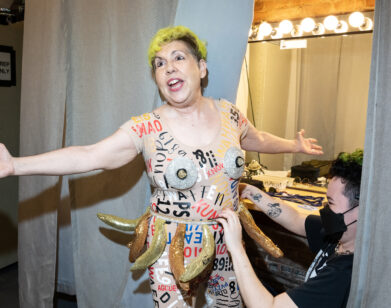Futura Reflects on the Past

IMAGE COURTESY OF FUTURA.
The pioneering graffiti artist Futura, whose work is synonymous with the downtown art scene of the early ’80s, will show his increasingly abstract and rhythmic compositions at Andy Valmorbida’s 560 Washington St. from Sept. 6, in his first solo exhibition in 12 years.
The exhibition, “Future Shock,” is a shout-out to the 1970 book by Alvin Toffler about the destabilizing effect of technology on society. Futura read the book in high school and was deeply affected by its dystopian prophecies, he had already changed his name from Leonard McGurr to Futura 2000 and Toffler’s book only solidified his fascination with the nature and acceleration of time. During these teenage years, Futura was “bombing” subway cars with graffiti as they snaked their way through the city.
Futura made a significant leap to the canvas in 1980, and in 1981 he toured with The Clash, painting live on stage as they performed throughout Europe. In 1983 Futura collaborated with Mike Jones (The Clash) writing and singing the lyrics to The Escapades of Futura 2000, a track that articulated his artistc manifesto at the time, proclaiming: “I guess I must admire—the need to set things on fire.” Futura has been active ever since, probing perceptions of public and private space, and transcending the barriers between street, commercial and fine art.
Here, Futura talks candidly to Interview about the precarious transition from the street to the gallery. The artist is excited to show works that fully embrace his developing lyricism and reflect his evolution as a painter.
ANGELA LEDGEROOD: You named yourself Futura 2000 when you were a teenager in the late ‘60s, and in 2000 you dropped the 2000…
FUTURA: After 2000 I had to let that go. When I was 15 it sounded interesting.
LEDGERWOOD: I’m sure at the time it felt like a long-term goal to get there.
FUTURA: To be quite honest I didn’t really think I’d make it.
LEDGERWOOD: Many of your contemporaries in that downtown scene didn’t make it.
FUTURA: Obviously it’s a realist tragedy. Every genre, every culture has fallen heroes. Keith [Haring], Jean-Michel [Basquiat], Andy [Warhol], yes, I knew Andy. I wasn’t as close to him as some of the others, but he was part of our movement.
LEDGERWOOD: You’ve said you’re a product of your environment; that street art was a part of your experience growing up.
FUTURA: I grew up on 103rd Street in Brooklyn and my introduction to graffiti was in the late ‘60s and early ‘70s. I’m taking the subway to school, walking, taking the bus, and on the route I’m seeing graffiti begin to appear and happen. So over the course of a few years I began to see the writing on the wall. I would think that’s why I wanted to participate in some way. It wasn’t until a decade later in 1979, 1980 that I would go downtown. Around 1981 the East Village bubbled into an actual art scene. But by 1981 I’m 25 or 26 so I’ve grown up from the embryonic state as a graffiti a writer. Growing up in that era I felt attune to a lot of things, the anti-war movement, civil rights, America’s landing on the moon. The late ’60s and early ’70s were influential in my life and in the life of our country. Specifically, the East Village was a later discovery for me, and couldn’t have happened without the other individuals that I knew, who really knew about art.
When I came back to New York in 1979 after being in the navy for four years, I’d been around the world, to Mombasa Kenya, Pakistan, Australia, all over Asia, the Philippines and Japan, and most of my friends hadn’t left the block. So I got a slow education in graffiti and went away, and came back believing I was mature and grown up only to re-connect with the graffiti community which had now progressed an evolved into something. It wasn’t just scribbling on the walls anymore; it was full productions, people doing amazing works of art. My returning to New York, post military, coincided with the meeting of Keith and Jean-Michel and by that time I knew a little more about art, I’d heard of the artists of the pop movement. When I first started making painting in 1979-81 people were comparing me to Kandinsky and making references to other artists throughout art history whom I had never heard of.
LEDGERWOOD: Did you think of that period as a conversation between artists? Or is that an idea imposed on the period in retrospect?
FUTURA: Not at the time. It was about a five-year period, I would say 1980 to 1985, or 1981- 86 and then it was essentially over. All the fashion and the hype, the “oh these kids have all this energy” had passed by. It was a huge wave that carried a lot of people along with it. Fab Five Freddy, Keith, Kenny and a lot of the young artists of that generation, we were really close and we shared a lot of information but it wasn’t until the early nineties that I started to consider myself as “an artist”.
The transition from the street and the subway to the gallery is a very difficult one, how do you justify the content of your work now that it’s in a gallery? Doesn’t it limit its power being off the public spaces? So there’s a lot of questions I had, and one thing that got me through the ‘80s was that in 1984 I had my son, and that was really the changing moment in my life.
LEDGERWOOD: You’ve also worked as a graphic artist.
FUTURA: In the nineties when that part of my art history was over a lot of kids were heading to Europe because they were very supportive of our work, but most people didn’t have a wife and a kid at the time, they were single and could go for it. There wasn’t the emotion attached as it was in making paintings. I enjoyed that type of work and at the same time I wasn’t stressed about the artist identity.
LEDGERWOOD: How has your creative process changed now that you’re creating works on canvas and large wooden boards? Is the impulse different if you know your work is going to be in a gallery setting?
FUTURA: I think when you come from a section of society where there aren’t really have any rules. The scale and the size of things can’t be calculated… if you look at a blank canvas, or some kind of artists medium and you’re required to work within the dimensions of that, all the things that used to scare me, I’m not intimidated by anymore. I look at a gallery space and I want to put work on the wall that’s going to consume the wall, as opposed to the way I used to think, which was the space is going to consume my work.
LEDGERWOOD: In the beginning there was a performance aspect to your work, like when you toured with The Clash in 1981, painting live on stage while they performed. Is music still part of that process?
FUTURA: I’m not how I used to be, where music was a necessary soundtrack to my life. I appreciate silence. It was a great period of my life to have had the opportunity not only to perform with them, but to know them.






